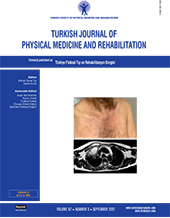Efficacy of foot-ankle orthosis on balance for children with hemiplegic cerebral palsy: An observational study
2 Department of Physical Medicine and Rehabilitation, Sancaktepe Şehit Prof. Dr. Ilhan Varank Training and Research Hospital, Istanbul, Turkey
3 Department of Physical Medicine and Rehabilitation, Division of Pain Medicine, Istanbul University, Istanbul Faculty of Medicine, Istanbul, Turkey
4 Department of Physical Medicine and Rehabilitation, Marmara University Faculty of Medicine, Istanbul, Turkey DOI : 10.5606/tftrd.2021.5175 Objectives: The aim of this study was to investigate the impact of ankle-foot orthoses (AFOs) on the balance and gait and to compare the effects of hinged AFOs with solid AFOs on balance in patients with cerebral palsy (CP).
Patients and methods: Between January 2015 and January 2016, 19 hemiplegic children with CP (11 males, 8 females; mean age: 9.5±2.2 years; range, 6 to 15 years) and 23 sex- and age-matched controls (8 males, 15 females; mean age: 10±1.6 years; range, 6 to 13 years) were included in this study. All patients were using either solid or hinged AFO. Hemiplegic patients were attended to specific tests with orthoses and barefoot. Pediatric Balance Scale (PBS) and Five Times Sit to Stand Test (FTSST) were used for functional evaluation. The quantitative balance was evaluated using the device-assisted balance tests, Limits of Stability (LOS), Walk Across (WA), and Sit to Stand (STS) tests.
Results: The control group had a better functional balance than the CP group (p<0.001 for PBS and p<0.001 for FTSST) and the CP group with AFO had a better balance than the barefoot (p=0.001 for PBS and p=0.009 for FTSST). Children with CP also showed a higher sway velocity in STS (p<0.001) than the control group. In patients with AFO, a decrease in the sway velocity in STS (p=0.037) and an increase in directional control in LOS (p=0.044) were observed, compared to barefoot.
Conclusion: The AFO use offers a significant contribution to the functional balance in CP. Prescribing AFOs are usually required in ambulatory CP patients in combined with a well-designed standard physiotherapy.
Keywords : Balance, hemiplegic cerebral palsy, postural stability
















